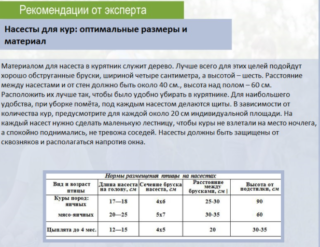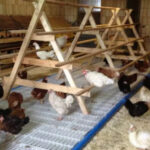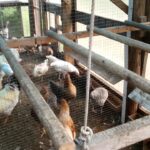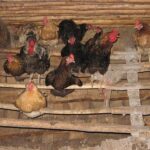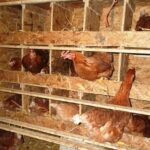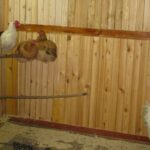A poultry house in the courtyard of a private house gives the owners a number of advantages with the competent organization of the internal space. Livestock should be kept in comfortable conditions with appropriate infrastructure. Correctly equipped perches in a chicken coop are one of its most important elements. There is nothing complicated in their manufacture, but a number of nuances must be taken into account.
What is a roost for?
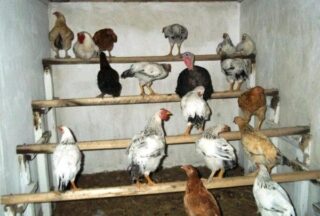
The need for roosting is dictated by several biological and psychological reasons. Birds need proper rest and healthy sleep, and this is achieved by proper planning of the chicken coop.
The presence of a roost is justified by the following factors:
- Instinctively, chickens prefer to sleep as far from the ground as possible. This gives them a sense of safety and protection from predators.
- The plumage should dry out and ventilate. Staying on a dirty and damp litter is fraught with the development of dangerous viral and fungal diseases.
- Chickens are gregarious animals, but preferring to have their own living space. In the cold they stray into groups, and in the summer they sleep separately.
To correctly make a roost in a chicken coop with your own hands, you need to carefully study the varieties, manufacturing technology and installation of these structures.
What should be the correct perch
Initially, you need to choose the correct cross-section of the pole. It should be close to round, about half the length of a laying hen's leg in width. The wood needs to be sanded so that it is splinter-free and not slippery. A rounded bar 4x6 cm is considered optimal.
The height of the poles should be in the range of 40-100 cm. If it is less, the chickens will not receive proper physical activity and will weaken. Excessive lifting is fraught with injury and even death if the bird falls.
The length is taken according to the number of individuals based on adult representatives of 30 cm and 15 cm for chicks. The longer the pole is, the better. Closeness is a reason for quarrels and fights between birds, and this is fraught with harm to their health and reduced productivity.
Poles that are too long sag under the weight of the animals. Therefore, props must be installed every 100 cm.
When mounted in several tiers, the poles should be spaced 30 cm.Thus, the individuals located above will not stain the lower ones with their droppings. The upper level must be made the most durable. There, in accordance with the hierarchy, the largest and strongest birds are located.
It is better to choose a place for the poles away from the door, so as not to frighten the livestock with a harsh light, to prevent a gust of wind and rain drops from falling on it.
Types of perches, their disadvantages and advantages
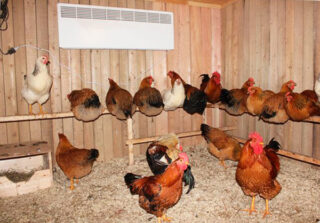
Perches by their design are divided into many varieties. Novice poultry farmers can use one of the following design options:
- Single-tiered. The easiest building to arrange and maintain. They represent a bar along the wall. They require a minimum of costs, but are limited in capacity.
- Multi-tiered. The slats are arranged like an inclined staircase at a certain interval. They take up more space, but are more practical in terms of accommodating large livestock.
- Corner. Great for small poultry houses.Poles are installed in one or more corners of the chicken coop. If necessary, do as many tiers as possible. Achieved space savings, but there is a risk of dampness of the floor and walls there. Cleaning is difficult, but this is solved by installing removable beams.
- Boxes. They are modules where perches, nests and pallets are combined. It is convenient in terms of regulating the usable area of the chicken coop by adding or removing boxes, but costly in terms of manufacturing, plus the complexity of individual cleaning.
- With pallets. Convenient and practical in terms of cleaning. The pallets are installed on supports under the poles. It takes time and effort, but the floors under the poles remain clean. Garbage is collected in a bag and taken out one by one.
- Portable or hygienic. They are made in the form of a table, on which a collapsible perch and a stand for collecting sewage are installed. Typically used as a temporary option for seasonal breeding.
- Lifting. The poles are not fixed rigidly, but are tied with ropes to the ceiling. When the chickens leave the barn, the bars rise up, the owners can freely engage in maintenance of the premises. A universal solution for buildings of any size.
- Above the nests (with egg collector). An economical option when boxes with nests are installed under the poles. A lot of free space is freed up, but you need to cover the nests so that they do not get contaminated with the waste products of birds. In winter or in bad weather, such coatings must be changed often.
The choice in favor of a particular design is made on an individual basis. The priorities of the owners, the size and configuration of the barn, the number of livestock contained in it are taken into account.
Manufacturing instruction
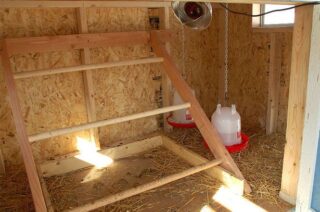
There is no particular difference in the principle of home improvement for chickens, therefore all work is carried out according to the same algorithm.
- Measure the structure. Compare the number of living creatures and the area they require for placement. This takes into account the dimensions of windows, doors and passageways between structures.
- Draw up a detailed drawing. On its basis, calculate the materials required for construction. Make a purchase with a margin of up to 15%.
- Prepare tools and equipment for work. Don't forget about your own safety. All manipulations should be performed with a helmet, glasses and gloves.
- Process the bars. Grind off the corners, sand the wood, burn it with a blowtorch for disinfection.
- Install pole supports on the walls. Make sure that the poles enter the openings freely, but do not scroll.
- Fasten the perches, make supports under them.
Finally, pallets and nests need to be installed.
Caring for perches
Poles for chickens do not require special care, but they cannot be neglected at all. Wood gets dirty, damp, whole colonies of pathogens develop on it. Periodically, the bars need to be removed, taken out into the street and dried in the sun. It is also necessary to clean them from dirt, treat them with an antiseptic and expose them to heat.
For the winter, if the chicken coop is not in use, it is better to transfer the poles to a dry and warm room. If signs of decay are found, it is better to replace such parts completely.
How to train birds to perch
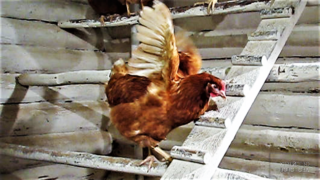
It is not uncommon for hens to refuse to sleep on the perches prepared for them.
The reasons may be as follows:
- bright light from the window opposite;
- insufficient distance of the pole to the wall, which the birds touch with their tails;
- too low or high height from the floor;
- form of the pole, inconvenient for gripping with paws.
If, after eliminating these factors, the chickens still refuse to take off into sleeping places, they need to be gradually tamed to them. After returning from a walk, you need to carefully take the birds and roost them. You need to do this every evening without missing a beat.As practice shows, in a maximum of a month, all living creatures get used to it and jump on poles on their own.

